It never ceases to amaze us how much the history of a particular food can really speak to the broader history of the culture behind it.
For flaouna (flaounes for plural), this delightful sourdough cheesy Easter dessert has become a pride and joy in Cyprus. But the recipe and its clear-cut Hellenistic roots are, interestingly, a relatively new introduction to the land and culture.
And so we’ll see here what exactly that means.

Cyprus, Flaounes, and the Spread of Hellenism
The modern day variation of flaounes are quintessentially Cypriot, but these little Easter dessert cheese tarts have distinct roots back to similar religious treats from the times of the ancient Greek Empire.
Prior to Christianity and the development of the Greek Orthodox faith, the ancient Greeks would make a treat called palathi, a sweetened bread made with nuts and figs, to offer to children who came door to door to sing about the onset of the spring. Over time, the ritual developed a religious connotation to it as Easter became a prominent mark in the Greek calendar, and palathi became effectively an “Easter dessert” for children singing about the resurrection of Jesus Christ.
Somewhat impressively, the tradition has remained largely the same throughout different Hellenistic cultures, and the Greek Cypriot culture is no exception. Nowadays, while palathi has been replaced as the de facto Easter dessert by more savory and delicious flaounes, this particular tradition still remains largely intact and similar to the original.
How this ritual even made it to Cyprus in the first place, however, is very much a story worth investigating.
Early Cyprus and the Onset of Hellenism
Nowadays, Cyprus has two large demographic groups within its population. There are the Christianity-ascribed Greek Cypriots, and then there are the Sunni Muslim Turkish Cypriots.
It wasn’t until fairly recently in our relatively short human history, however, that Cyprus had such close ties to larger outside cultural powers. In fact, for a very long time, Cyprus itself was a larger cultural power.
Few might realize that Cyprus has been home to some of the most exciting archaeological discoveries of recent memory that demonstrate an advanced society that precedes any Greek or Arab influences. For example, a 2004 discovery found the remains of ~9,500 year old remains of a young cat alongside its human owner… a discovery that is now easily the earliest known relationship between humans and felines by a long shot.
And that’s just the tip of the iceberg. There are a whole slew of clues to suggest that, prior to the period of “empire hopping” and eventually Alexander the Great, Cyprus was home to some of the most advanced and powerful societies anywhere in the Levant.
Of course, eventually this small nation succumbed (several times over) to the wants and needs of its larger burgeoning empire neighbors, which brings us closer to the Cyprus that we know today.
The Ptolemaic Era and Hellenism
By the 7th Century BC, Cyprus was first annexed by the Assyrian Empire and would, over several centuries, “change hands” between different empires. Before the arrival of Alexander the Great in the 4th century BC, the Cypriots were also a prominent part of the Persian Empire as well.
The year ~321 BC proved to be a pivotal point in the history of Cyprus, however. Following a successful campaign against the Persians – and thanks to the help of Cypriot forces at the battle of Tyre – Alexander the Great and the Macedonian Empire successfully claimed large swathes of former Persian land, a group to which Cyprus belonged. Under Alexander, the Cypriots were able to enjoy full autonomy, both politically and culturally, but these good times proved to be short-lived.
Unfortunately for most, Alexander died without leaving a clear cut heir to the throne, an omission that led to a major power vacuum between most of Alexander’s former generals. Eventually, Ptolemy I emerged victorious and would lay claim to Cyprus as part of his new Empire, one which preached less tolerance and autonomy than that of his predecessor.
The period of Ptolemaic rule proved to be devastating to what you could consider “native Cypriot” culture. In a move that triggered what we now considered pan-Hellenism – or the spread of the ancient Greek culture throughout the world – Ptolemy abolished many local practices in favor of adhering to his greater central authority. One of the greatest casualties of this all was the loss of the original Cypriot script, a writing system that ceased to be used almost overnight.
Greek Cyprus and Turkish Cyprus
Now, to be fair, Cyprus does have an entirely different part of the population that draws on far different influences. Thanks to a pretty unprecedented stable commercial relationship between the Byzantines and the Arabs, Cyprus has a very significantly present “other side of the cultural house.”
A discussion about the Turkish Cypriot culture and cuisine, however, will have to be saved for another day. And when it does, there will be some really delicious recipes and equally intriguing stories to discuss as well.
For now, though, back to flaounes.
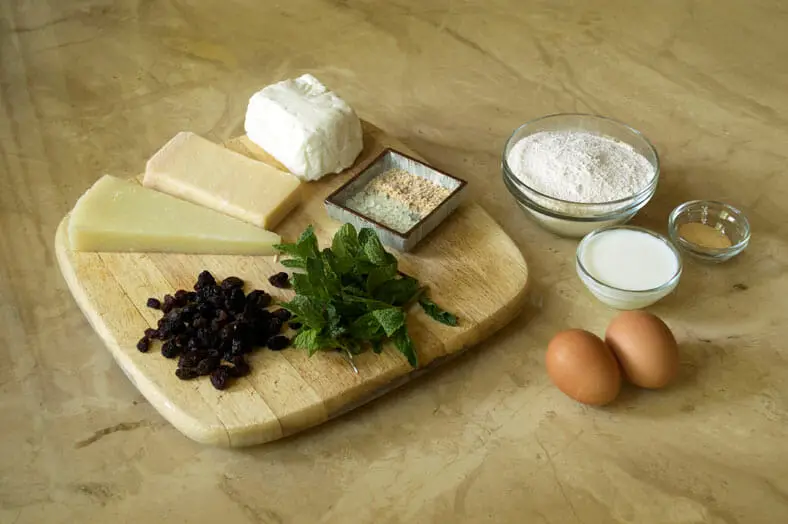
About this Easter Dessert Recipe
Making flaounes is one of those experiences where, amid all the hard work and preparation, you come to appreciate the art of cooking and even pick up a few extra tricks along the way. It is, by no means, an easy recipe to prepare, but the end result is very well worth it.
To make flaounes, there are three key greater components for the Easter dessert: the dough, the filling, and the preparation of the shapely cheese tarts themselves.
The Filling
First, we’ll take a look at the delicious and complex cheesy filling. In the most traditional versions of flaounes, you’ll find a combination of cheeses very special to the region. For example, there’s the kefalotyri that in Cyprus is sometimes even referred to as the “flaounes cheese,” and there’s also halloumi cheese as well.
Unfortunately for most of us outside of Cyprus, finding these cheeses can pose a bit of a problem, especially for the kefalotyri. Halloumi is more common and very doable to find, but it too might require a bit of a search. We’ll discuss this more in the next section about this, but you can still continue on making your flaounes with perfectly acceptable “internationalized” cheese substitutes.
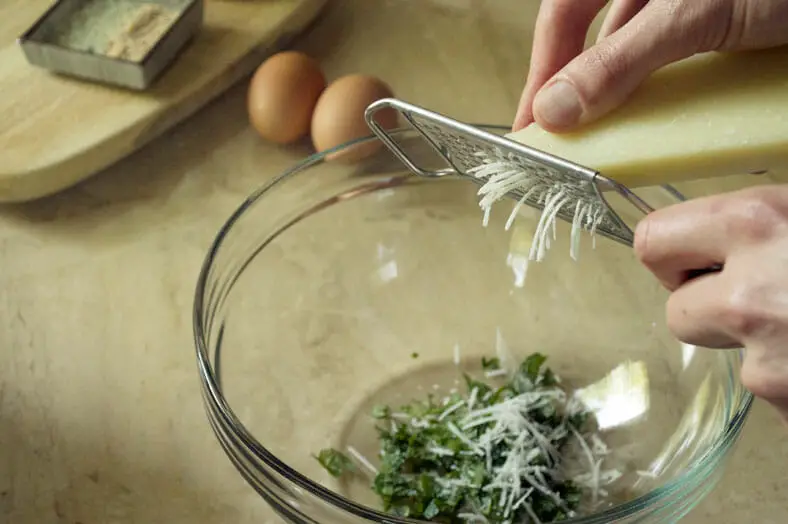
The actual making of the cheesy filling proved to be a pretty interesting process in and of itself. First, you grate all your cheese into a large bowl and mix them together with your hands. Next, you’ll add fragrant ingredients like mint, raisins, mahlab and mastic (more on the latter two in a bit) and mix into your cheese filling… again with your hands.
From there, you’ll add a small portion of baking powder and eggs – mixing in with, you guessed it, your hands – to create a pseudo-dough of cheesy flaounes filling that you’ll set aside to bind and rise for at least several hours. When it comes close to time to compile the entire flaounes, you’ll add another bit of leavening baking powder before showtime.

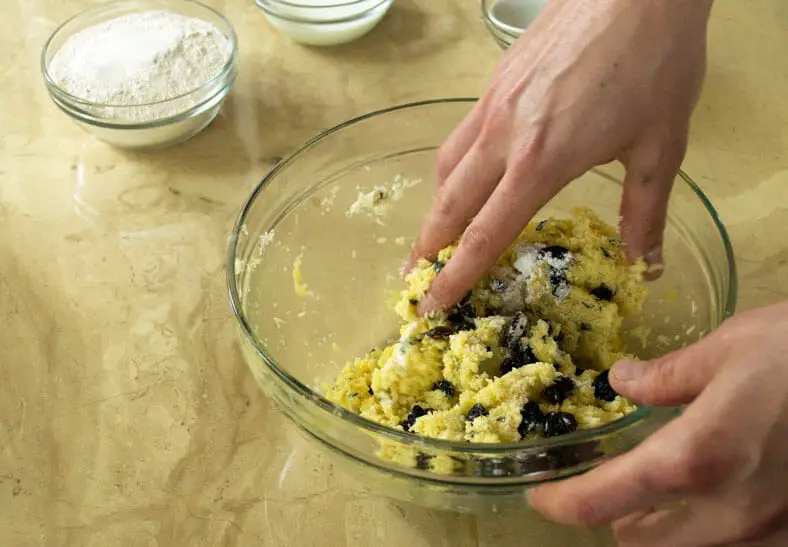
Now onto the dough.
The Dough
For the most part, the dough for this Easter dessert isn’t terribly different from most other types of dough you might find for a pastry. Sure, it might come out a little creamier thanks to some milk and butter added, but otherwise it’s nothing too crazy.
Where it does get a little out there, though, is with two key flavorings to the dough itself: mahlab and mastic. Both are aromatics that are used for all sorts of recipes around Cyprus and in various Middle Eastern and North African cuisines, and both carry very distinguishable (even addicting!) flavors.
Mahlab is an aromatic spice that’s made from the seeds of a special species of cherry that come from a particular Persian cherry tree. This tree thrives mostly in the Mediterranean, Iran and parts of Central Asia, and its seeds carry a very distinct flavor that you could say mixes the smoothness of an almond taste with the bite of a sour cherry. To use mahlab, you can either get it pre-ground or grind down the seeds, and you can use it to add a very unique flavor to just about anything. Just be warned that a little bit will go a long way with this spice.
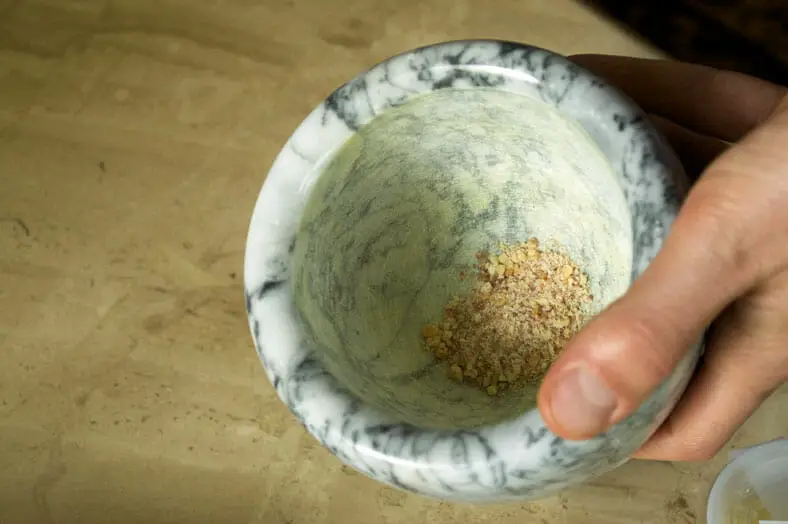
Mastic, on the other hand, isn’t so much a seed or a spice but rather a type of gum. Coming from a special tree originally from the small Greek island of Chios, the sap and resin from this tree is hardened into what becomes a sort of hardened crystal. You can take a crystal and grind it down – like we will here in flaounes – or you can even start to chew it. Mastic gum actually was considered the first true and all-natural chewing gum out there.

For this flaounes dough, though, you start by taking both the mahlab and the mastic and grinding them down into a mortar and pestle. Once they’re ground down to a reasonable degree, you add them to your dry mixture of dough before mixing in the wet ingredients. Let your dough sit as you would for any other dough using yeast as a leavening agent, and then you’re ready to go.
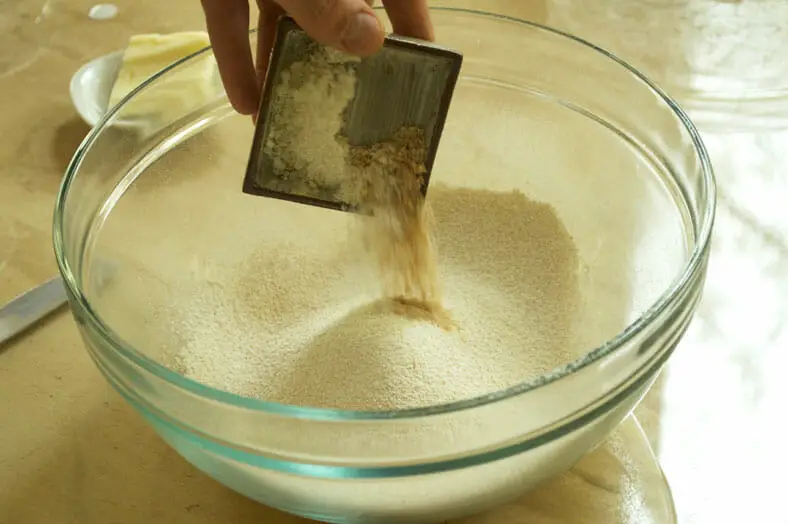


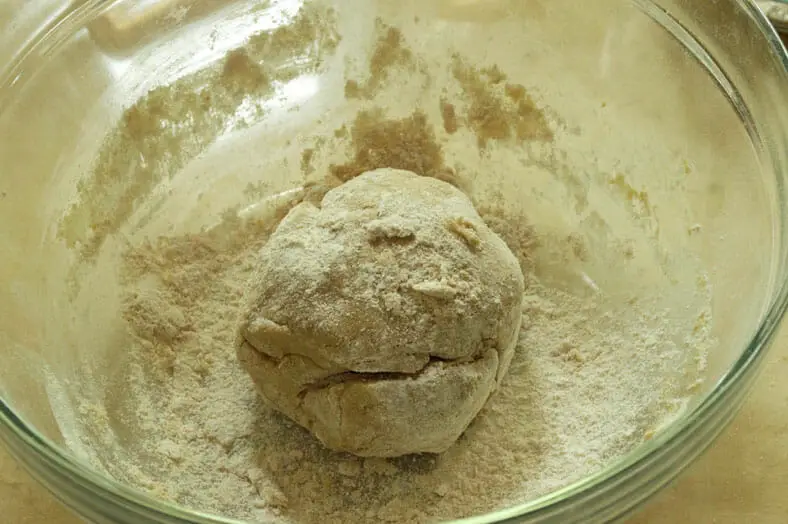
A quick tip, though, is to be careful not to grind down your mastic too much, otherwise you’ll end up with a gum-like substance lined all throughout your mortar and pestle. Unfortunately, it can be kind of messy to clean up!
The Folding
Once you have your cheese filling and your dough ready to go, you’re ready to create your flaounes into the cute triangular shape that is distinctive to this Easter dessert.

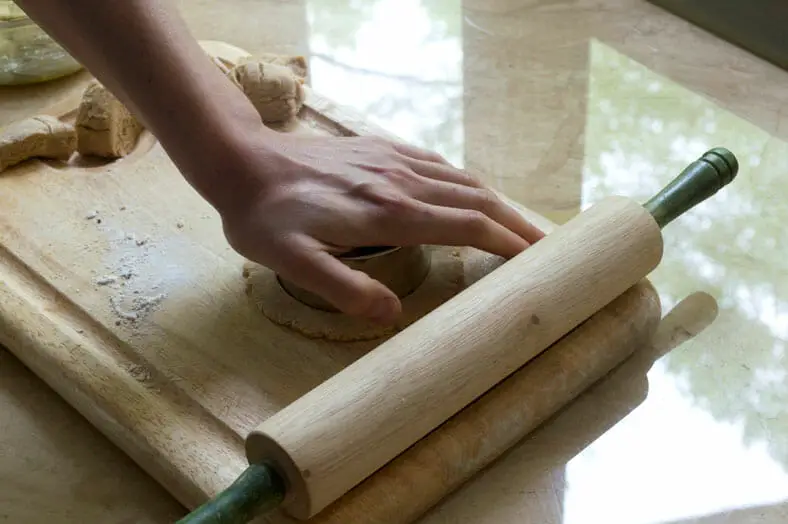
To start, you’ll take a small circle of cut out down, and you’ll dip one side of it into a plate of moistened sesame seeds. On the non-seeded side, you’ll place a spoonful of your cheese filling into the center, then you’ll proceed to fold one side of the circle directly into the middle.

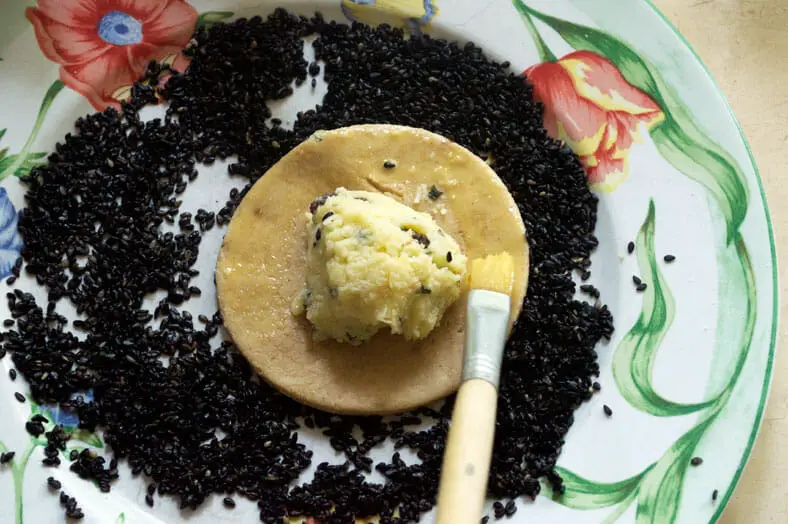
You’ll do three folds in total for your entire dough, and what you’ll end up with is a triangular tart where the corners are looped over one another. Rinse and repeat until you’ve used up all your dough and filling, then you can pop your flaounes into the oven to bake!
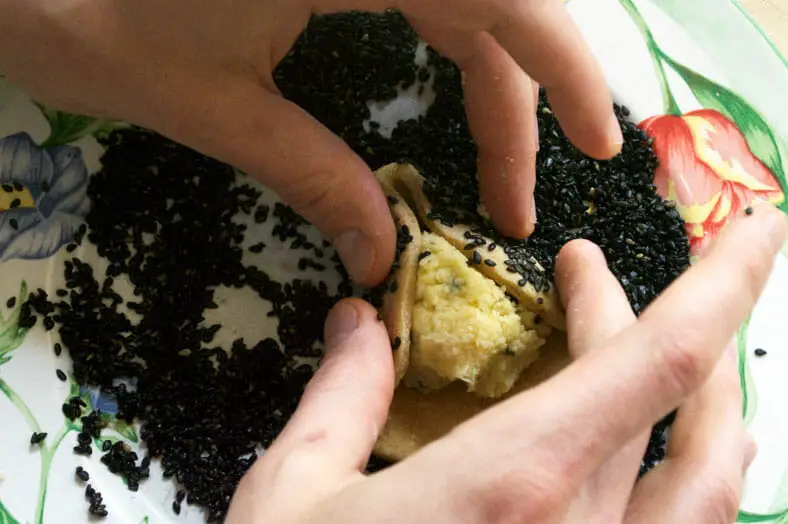
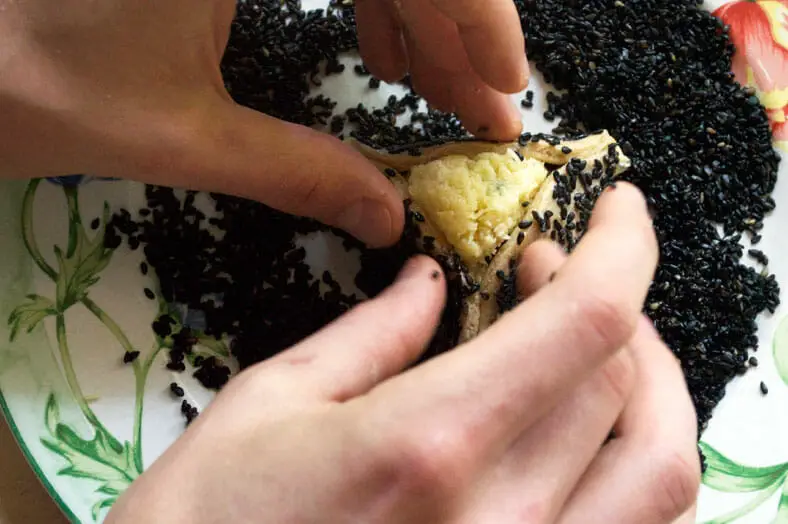
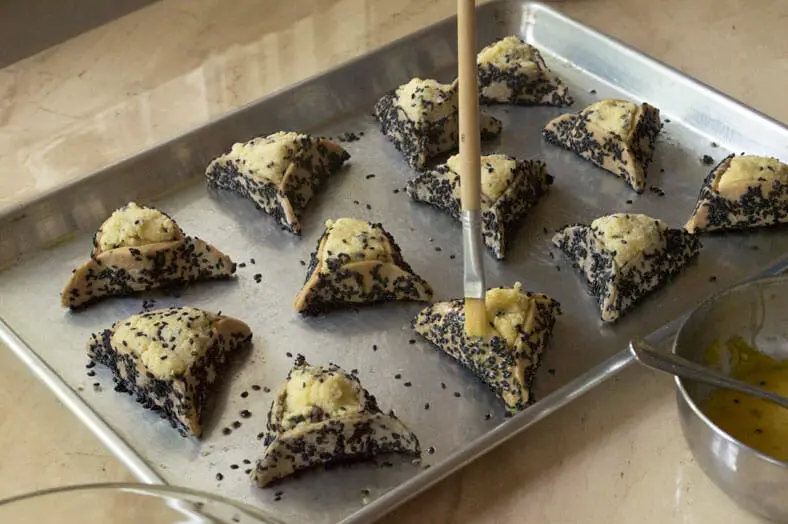
When you take the flaounes out, prepare to be amazed (and excited) by the rise of the cheesy filling as it puffs up through the opening at the top of the tart.
Our Take on the Recipe
What makes our job slightly easier when exploring these recipes is finding the right type of references that really seem to know their stuff about the recipes and the host cuisines in general. For this flaounes recipe and for Cypriot cuisine as a whole, we loved the type of knowledge the author of our original reference recipe had, which is why we ended up following her lead.
Most of the adjustments made had to come in the area of the cheeses. In the absence of true “flaounes cheese,” we had to get a little creative and make an adequate mix. Through our research, we found that you can still have a perfectly suitable set of flaounes so long as you include one hard cheese made from goat’s milk and one made from cow’s milk.
Using this rule as guidance, we created a mixture of pecorino romano (goat’s milk) and parmegano reggiano (cow’s milk) that were more readily available near to us. We were also able to find halloumi though, and so it too made it into the mix.
For the other adjustments, we did cut down the incredibly large proportions of the original recipe. Making something close to 1/6 of the original recipe, we feel our version of this Easter dessert might be more suited for 2-4 consumers instead of a smaller local community.
Finally, we did make some smaller swaps as well. We our customary substitution for coconut sugar instead of white sugar, and we actually liked using black sesame seeds on the outside of our flaounes.
Other than that, it’s safe to say that flaounes are one of those recipes – both in terms of ingredients and procedure – that we had not yet encountered. We’re glad we have, though, since it is a delectable insight into what has become a traditional Cypriot Easter dessert.
Enjoy!
What would you put into your flaounes filling? Comment below! 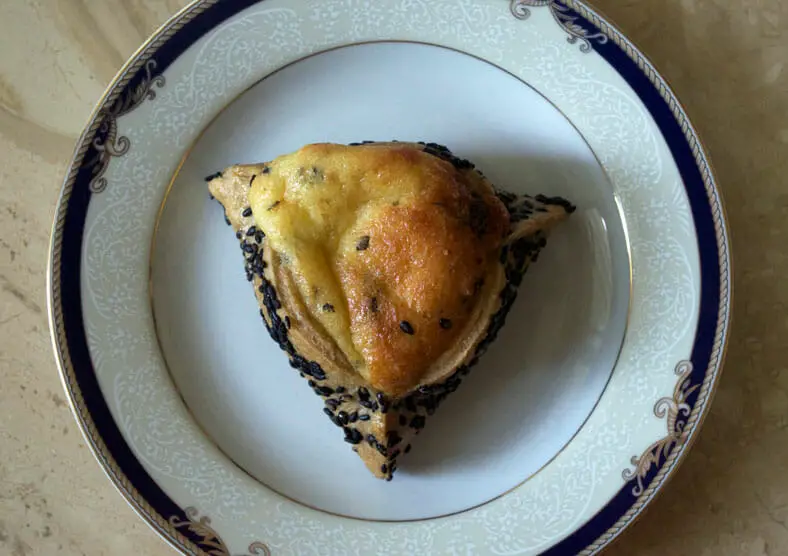

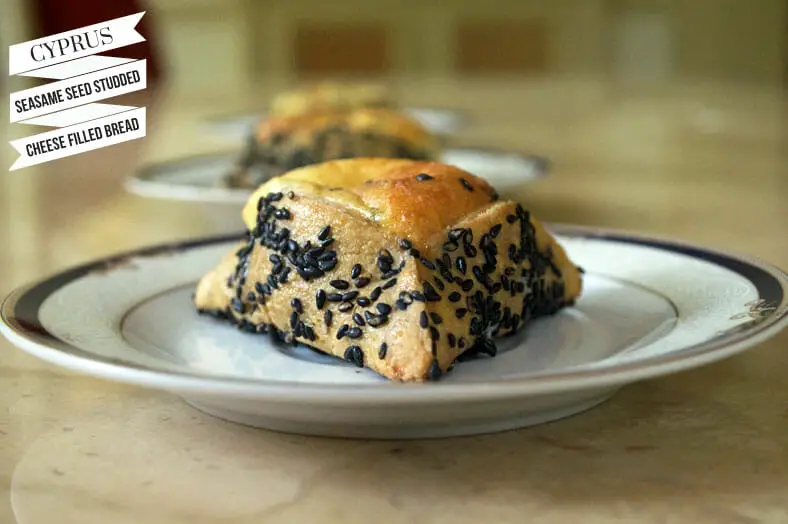
Always love the historical backdrop you add not only about the food but the country in general! Forget about easter, I’d like to eat this bread all the time! 😉
As would we, Manila Spoon 🙂 We actually made a fresh batch just recently again, even though Easter isn’t for another 10 months. Glad you liked the history too!
Heather and Cyrus- I’ve missed you guys! This looks amazing and I love how it has haloumi cheese IN IT- So unique!
We’ve missed you too, Arman! We seem to share an appreciation for halloumi cheese too.. it’s one of those special joys in life 🙂
As always, I benefit from your history and cultural ethnography lesson. (If only I could remember it well, instead of just having a vague sense of what you said a day or two later.) As to the flaounes, they look amazing and though I have never seen or used mastic or mehlep, the shape and general idea is close to the Jewish pastry for Purim, hamantaschen or Haman’s hat. Do you know it? Rich, triangular-shaped pastry wrapped around a filling that can range from poppy seed to chocolate (or nutella in one of my variations.) Another more modern Jewish pastry that is similar is the venerable cheese danish (but no sesame seeds, mastic or mehlep of course:)
Thank you for the kind words as always Laura! No I haven’t heard of the Jewish pastry you speak of, although it sounds like an absolute winner (anything with chocolate or nutella is by default). Do you have a recipe you could share with us? 🙂
You can have different shapes not so many people make triangular flaounes in famagusta and larnaca as far as I know people make them in a different shape. Where I leave we do them a bit bigger and squared-ish
You can have different shapes not so many people make triangular flaounes in famagusta and larnaca as far as I know people make them in a different shape. Where I leave we do them a bit bigger and squared